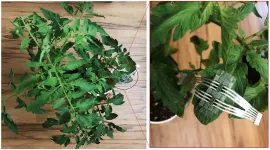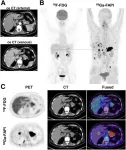Four new studies from the University of Illinois explore chemical-free pretreatment methods, development of high-throughput phenotyping methods, and commercial-scale techno-economic feasibility of producing fuel from energycane in various scenarios.
The studies are part of the ROGUE (Renewable Oil Generated with Ultra-productive Energycane) project at U of I. ROGUE focuses on bioengineering accumulation of triacylglycerides (TAGs) in the leaves and stems of energycane, enabling the production of much more industrial vegetable oil per acre than previously possible.
"The productivity of these non-food crops is very high per unit of land. Soybean is the traditional crop used for biodiesel, but we can get higher yield, more oil, and subsequently more biofuel from lipid-producing energycane," says Vijay Singh, Founder professor in the Department of Agricultural and Biological Engineering (ABE) at U of I and co-author on all four papers.
Biofuel production from crops involves breaking down the cellulosic material and extracting the oil in a series of steps, explains study co-author Deepak Kumar, assistant professor in the Chemical Engineering Department at State University of New York College of Environmental Science and Forestry (SUNY-ESF) and adjunct research scientist at the Carl R. Woese Institute for Genomic Biology at U of I.
"The first step is to extract the juice. That leaves bagasse, a lignocellulosic material you can process to produce sugars and subsequently ferment to bioethanol," Kumar says.
"One of the critical things in processing any lignocellulosic biomass is a pretreatment step. You need to break the recalcitrant structure of the material, so enzymes can access the cellulose," he adds. "Because energycane is a relatively new crop, there are very few studies on the pretreatment and breakdown of this bagasse to produce sugars, and to convert those sugars into biofuels."
The pretreatment process also yields some unwanted compounds, which inhibit enzymes that convert the sugar into biofuels. The U of I researchers investigated the best pretreatment methods to maximize the breakdown while minimizing the production of inhibitors. Typically, the pretreatment process uses chemicals such as sulfuric acid to break down the biomass at high temperature and pressure.
"We use a chemical-free method, which makes it more environmentally friendly," Kumar explains. "Furthermore, harsh chemicals may alter the oil structure or quality in the biomass."
The researchers tested their method using nine different combinations of temperature and time intervals. They were able to achieve more than 90% cellulose conversion at the optimal conditions, which is equivalent to results from chemical pretreatment methods.
The second study built on those results to further investigate the relationship between temperature, inhibitor production, and sugar recovery.
"We pretreated the lignocellulosic biomass over a range of different temperatures to optimize the condition for minimal inhibitor generation without affecting the sugar recovery. Then we added cryogenic grinding to the process," says Shraddha Maitra, postdoctoral research associate in ABE and lead author on the study.
"In cryogenic grinding, you treat the bagasse with liquid nitrogen, which makes it very brittle, so upon grinding the biomass fractures easily to release the sugars. This further increased sugar recovery, mainly xylose, by about 10% compared to other refining processes," Maitra explains.
Other industries use similar methods, for example for spices and essential oils, where it is important to preserve the qualities of the product. But applying them to biofuel production is new.
In a third study, Maitra and her co-authors investigated time-domain nuclear magnetic resonance (NMR) technology to determine the stability and recovery of lipids by monitoring changes in total, bound, and free lipids after various physical and chemical feedstock preprocessing procedures.
The research team's fourth study investigated the commercial-scale techno-economic feasibility of engineered energycane-based biorefinery. They used computer modeling to simulate the production process under two different scenarios to determine capital investment, production costs, and output compared with soybean-based biodiesel.
"Although the capital investment is higher compared to soybean biodiesel, production costs are lower (66 to 90 cents per liter) than for soybean (91 cents per liter). For the first scenario, processing energycane had overall slightly lower profitability than soybean biodiesel, but yields five times as much biodiesel per unit of land," says Kumar, the lead author on the study.
"Energycane is attractive in its ability to grow across a much wider geography of the U.S. south east than sugarcane. This is a region with much underutilized land, yet capable of rain-fed agriculture," says ROGUE Director Steve Long, Ikenberry Endowed Chair of Plant Biology and Crop Sciences at the University of Illinois.
"As a perennial, energycane is suitable for land that might be damaged by annual crop cultivation. Our research shows the potential to produce a remarkable 7.5 barrels of diesel per acre of land annually. Together with co-products, this would be considerably more profitable than most current land use, while having the potential to contribute greatly to the national U.S. goal of achieving net zero greenhouse gas emissions by 2050. This proves how valuable it is to build on the successes already achieved in bioengineering energycane to accumulate oils that are easily converted into biodiesel and biojet," Long states.
INFORMATION:
The first study, "Chemical free two-step hydrothermal pretreatment to improve sugar yields from energy cane," is published in Energies. [doi.org/10.3390/en13215805]. Authors include Ankita Juneja, Deepak Kumar, Vijay Kumar Singh, Yadvika, and Vijay Singh.
The second study, "Balancing sugar recovery and inhibitor generation during energycane processing: Coupling cryogenic grinding with hydrothermal pretreatment at low temperatures," is published in Bioresource Technology. [doi.org/10.1016/j.biortech.2020.124424]. Authors include Shraddha Maitra and Vijay Singh.
The third study, "Development and validation of time-domain 1H=NMR relaxometry correlation for high-throughput phenotyping method for lipid contents of lignocellulosic feedstocks," is published in GCB Bioenergy. [https://doi.org/10.1111/gcbb.12841]. Authors are Shraddha Maitra, Bruce Dien, Stephen Long, and Vijay Singh.
The fourth study, "Techno-economic feasibility analysis of engineered energycane-based biorefinery co-producing biodiesel and ethanol," is published in GCB Bioenergy. Authors include Deepak Kumar, Stephen Long, Amit Arora, and Vijay Singh. [https://doi.org/10.1111/gcbb.12871]
Partial funding for the studies was provided by the Biological and Environmental Research (BER) program, U.S. Department of Energy, under Award Number DE-SC0018254.
The Department of Agricultural and Biological Engineering is in the College of Agricultural, Consumer and Environmental Sciences and The Grainger College of Engineering, University of Illinois.






